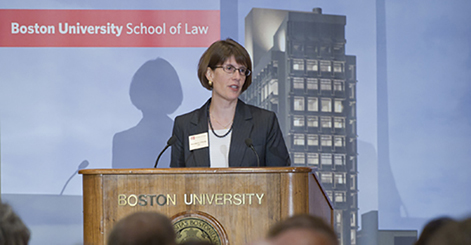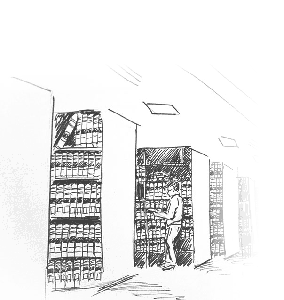Maureen O’Rourke may be her own best example of where preparation and prescience can take technology-savvy lawyers. The dean of Boston University School of Law, O’Rourke was among the first to immerse herself in the crosscurrents of the Internet and copyright law. She literally co-wrote the book “Copyright in a Global Information Economy,” one of the leading U.S. casebooks on the subject.
O’Rourke began her career as an attorney at IBM Corp. in 1990, working on software licensing, before joining the BU Law faculty in 1993. She helped supervise the student-run “Journal of Science and Technology Law” and won the school’s highest teaching honor – the Metcalf Award – in 2000. She became the dean in 2006 after two years as interim dean.

Not surprisingly, she sets as an imperative ensuring that BU law students have “transferable skills and an entrepreneurial spirit” as technology torques the practice of law.
O’Rourke, who completed her legal studies at Yale Law School, was among the first deans to answer a series of questions that Lawdragon is asking all law school deans in the U.S. as part of our new website devoted to legal education, which is launching this month.
LAWDRAGON: What drew you into academia?
MAUREEN O’ROURKE: A love for teaching. I worked in accounting for two years after my undergraduate education, went to law school and then practiced for three years in IBM’s legal department doing software licensing. While working at IBM, I taught Business Law as an adjunct at my undergraduate alma mater – Marist College in Poughkeepsie, NY. I discovered my passion for teaching then and there. I still have that love after 20 years.
LD: What distinguishes Boston University Law School from other law schools?
MO: A number of things. Let me enumerate a handful:
1) Excellent teaching. We always rate at or near the top of any survey of teaching quality.
2) Location, location, location – not just with easy access to the courts and legislative bodies of a state capital, but also within the fourth-largest private urban research university in the country. This offers our students incredible opportunities for work in the City of Boston and education in BU’s schools and colleges besides the law school.
3) One of the largest portfolios of international programs in the country – 17 – ranging from study abroad to combined three-year JD/LLM programs.
4) Opportunities to obtain practical skills. Every student who wants a clinical opportunity has one and more than 70 percent of our students participate in clinics and externships around the country and the world. The faculty-to-student ratio is kept between 5:1 and 8:1, and our clinics and externships span the legal field, encompassing employment rights, housing law, immigration, criminal law, government lawyering, health law, judicial law, human-trafficking, international human rights, legislative practice and much more.
5) The breadth and depth of our curriculum. JD students can choose from among more than 200 classes and seminars in their 2L and 3L years.
6) Alumni base. With more than 23,000 alumni practicing in 50 states and around the world, we have a powerful network of support for our students.
7) A new physical facility opening in Fall 2014: The Sumner M. Redstone Building will serve as our new student center and the hub of student life.
It’s hard to capture the character of a place in words: We aspire to be a forward-thinking law school for career-savvy students. Excellent teaching is in our DNA, our students are smart and motivated, and we have created a great community for the study of law.
LD: Are there programs, clinics or new initiatives you’d like to highlight?
MO: Yes, three I’ve mentioned and two others I’m also excited about.
Transactional Law Program: This program, which we began in 2011, teaches students transactional practice skills that they will need when they begin their careers: drafting contracts, analyzing and negotiating business agreements, conducting due diligence and organizing a closing. Employer and student feedback on this program has been uniformly positive – our graduates begin work with the skills of second-year associates.
Human-Trafficking Clinic: In our newest clinic, students work on human-trafficking cases. They represent individuals applying for T-visas, a special form of immigration relief for trafficking survivors facing deportation. Students also collaborate with survivors of human-trafficking, law enforcement, government officials and non-governmental organizations to identify solutions to combat human-trafficking.
Sumner M. Redstone Building: We are thrilled to be opening the Redstone Building next fall – a state-of-the-art law school building designed to meet students’ needs. It is five stories high and filled with modern classrooms, comfortable meeting spaces, practice moot courtrooms, a larger law library, and right-sized facilities for our transactional law and executive education programs. We still have our 18-story tower, which will soon be completely renovated and will house mostly administrative offices and student organizations – no more waiting in elevator lines before class.
1L Career Conference: Last year, we inaugurated what is now an annual event, a 1L Career Conference, organized and run by our Career Development & Public Service Office. We require all first-year students to attend. They learn about various practices areas, are introduced to the legal job search process and network with our alumni. It gives them a head start in thinking about their legal careers.
Prospective Student Financial Planning Calculator: We launched the financial planning calculator last year because we want our students to understand what law school will cost and help them create a plan for financing their legal education. The calculator provides the cost of attendance for three years, factors in the sources of financial support that the student expects to receive from scholarships, loans and savings, and determines the approximate amount of debt that the student will incur for his or her legal education. It also helps students understand what their repayment obligations will be at various income levels.
LD: What are your biggest challenges as dean and how are you meeting them?
MO: My biggest challenges relate primarily to the uncertainty of our technological and economic environments. We don’t know where technology is going or how it will further change the practice of law. And we can’t be sure about what sectors of the economy will need lawyers in the future. Against that backdrop, my goal is to equip our students with transferable skills and an entrepreneurial spirit to prepare them to deal with whatever changes are ahead. We’re already embarked on this in the initiatives I mentioned.
Finances are always a challenge. We want to find ways to keep our class size low and our education affordable. We are currently in the middle of a capital campaign that we hope will help us achieve these goals.
LD: Are you seeing any trends in the types of jobs BU graduates are taking?
MO: We are seeing increasing numbers of students take jobs in small and mid-size firms, corporations and the government. We also are seeing more students go out on their own, whether as solo practitioners or, more often, as part of entrepreneurial ventures.
LD: What do you do outside the law school when you’re not being dean?
MO: When I’m not working, I am most likely reading; watching TV – Revenge on ABC is a particular guilty pleasure; playing tennis; rooting on my favorite NY sports teams – the Yankees and Giants, or trying out the latest restaurant in town.

